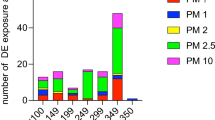Abstract
Diesel exhaust is a common air pollutant and work exposure has been reported to cause discomfort and affect lung function. The aim of this study was to develop an experimental setup which would allow investigation of acute effects on symptoms and lung function in humans exposed to diluted diesel exhaust. Diluted diesel exhaust was fed from an idling lorry through heated tubes into an exposure chamber. During evaluations of the setup we found the size and the shape of the exhaust particles to appear unchanged during the transport from the tail pipe to the exposure chamber. The composition of the diesel exhaust expressed as the ratios CO/NO, total hydrocarbons/NO, particles/NO, NO2/NO, and formaldehyde/NO were almost constant at different dilutions. The concentrations of NO2 and particles in the exposure chamber showed no obvious gradients. New steady state concentrations in the exposure chamber were obtained within 5–7 min. In a separate experiment eight healthy nonsmoking subjects were exposed to diluted exhaust at a median steady state concentration of 1.6 ppm NO2 for the duration of 1 h in the exposure chamber. All subjects experienced unpleasant smell, eye irritation, and nasal irritation. Throat irritation, headache, dizziness, nausea, tiredness, and coughing were experienced by some subjects. Lung function was not found to be affected during the exposure. The experimental setup was found to be appropriate for creating different predetermined steady state concentrations in the exposure chamber of diluted exhaust from a continuously idling vehicle. The acute symptoms reported by the subjects were relatively similar to what patients reported at different workplaces.
Similar content being viewed by others
References
Attfield MD, Trabant GD, Wheeler RW (1982) Exposure to diesel fumes and dust at six potash mines. Ann Occup Hyg 26:817–831
Ayres SM, Evans R, Licht D, Griesbach J (1973) Health effects of exposure to high concentrations of automotive emissions. Arch Environ Health 27:168–178
Borg GAY (1982) Psychophysical bases of perceived exertion. Med Sci Sports Exerc 14:377–381
Bourne HG Jr, Seferian S (1959) Insufficiently polymerized resins, used for wrinkle-proofing clothing, may liberate toxic quantities of formaldehyde. Ind Med Surg 2:232–233
Cernansky NP (1983) Diesel exhaust odor and irritants: a review. J Air Poll Contr Assoc 33:97–104
Gamble J, Jones W, Hudak J (1983) An epidemiological study of salt miners in diesel and nondiesel mines. Am J Ind Med 4:435–458
Gamble J, Jones W, Minshall S (1987a) Epidemiological-environmental study of diesel bus garage workers: acute effects of NO2 and respirable particulate on respiratory system. Environ Res 42:201–214
Gamble J, Jones W, Minshall S (1981b) Epidemiological-environmental study of bus garage workers: chronic effects of diesel exhaust on the respiratory system. Environ Res 44:6–17
Hackney JD, Thiede FC, Linn WS, Pedersen EE, Spier CE, Law DC, Fischer DA (1978) Experimental studies on human health effects of air pollutants. IV. Short-term physiological and clinical effects of nitrogen dioxide exposure. Arch Environ Health 33:176–181
Levin JO, Lindahl R, Andersson KA (1986) A passive sampler for formaldehyde in air using 2,4-dinitrophenylhydrazine-coated glass fiber filters. Environ Sci Technol 20:1273–1276
Reger R, Hancock J, Hankinson J, Hearl F, Merchant J (1982) Coal miners exposed to diesel exhaust emissions. Ann Occup Hyg 26:799–815
Schuck EA, Stephens ER, Middleton JT (1966) Eye irritation response at low concentrations of irritants. Arch Environ Health 13:570–575
Schuetzle D (1983) Sampling of vehicle emissions for chemical analysis and biological testing. Environ Health Perspect 47:65–80
Ulfvarson U, Alexandersson R (1990) Reduction in adverse effect on pulmonary function after exposure to filtered diesel exhaust. Am J Ind Med 17:341–347
Ulfvarson U, Alexandersson R, Aringer L, Anshelm-Olson B, Ekholm U, Hedenstierna G, Hogstedt C, Holmberg B, Lindstedt G, Randma E, Rosen G, Sorsa M, Svensson E (1985) Häl-soeffekter vid exponering för motoravgaser (Health effects of exposure to motor exhaust gases) (in Swedish, English summary). Arbete och Hälsa 5:1–83
Ulfvarson U, Alexandersson R, Aringer L, Svensson E, Hedenstierna G, Hogstedt C, Holmberg B, Rosen G, Sorsa M (1987) Effects of exposure to vehicle exhaust on health. Scand J Work Environ Health 13:505–512
Ulfvarson U, Alexandersson R, Dahlqvist M, Ekholm U, Bergström B (1991) Pulmonary function in workers exposed to diesel exhausts: the effect of control measures. Am J Ind Med 19:283–289
Author information
Authors and Affiliations
Rights and permissions
About this article
Cite this article
Rudell, B., Sandström, T., Hammarström, U. et al. Evaluation of an exposure setup for studying effects of diesel exhaust in humans. Int Arch Occup Environ Health 66, 77–83 (1994). https://doi.org/10.1007/BF00383361
Received:
Accepted:
Issue Date:
DOI: https://doi.org/10.1007/BF00383361




